Coal Discards and Sewage Sludge Derived-Hydrochar for HIV Antiretroviral Pollutant Removal from Wastewater and Spent Adsorption Residue Evaluation for Sustainable Carbon Management
Abstract
1. Introduction
2. Experimental Method
2.1. Materials
2.2. Methods
2.3. Physicochemical and Textural Analyses
3. Results and Discussion
3.1. HTC and Co-HTC Statistical Analysis
3.2. Optimum Operating Conditions
3.3. Adsorption Results
3.4. Proximate, Ultimate, and BET Analysis
3.5. Production and Evaluation of AC from Spent Hydrochar Residues from Nevirapine and Lamivudine Adsorption Tests
3.6. Electrochemical Characterization
4. Conclusions
Author Contributions
Funding
Institutional Review Board Statement
Informed Consent Statement
Data Availability Statement
Conflicts of Interest
References
- Blesa, M.J.; Miranda, J.L.; Moliner, R.; Izquierdo, M.T.; Palacios, J.M. Low-temperature co-pyrolysis of a low-rank coal and biomass to prepare smokeless fuel briquettes. J. Anal. Appl. Pyrolysis 2003, 70, 665–677. [Google Scholar] [CrossRef]
- Mills, E.L.; Ryan, D.G.; Prag, H.A.; Dikovskaya, D.; Menon, D.; Zaslona, Z.; Jedrychowski, M.P.; Costa, A.S.H.; Higgins, M.; Hams, E. Itaconate is an anti-inflammatory metabolite that activates Nrf2 via alkylation of KEAP1. Nature 2018, 556, 113–117. [Google Scholar] [CrossRef] [PubMed]
- Onifade, M.; Genc, B.; Bada, S. Spontaneous combustion liability between coal seams: A thermogravimetric study. Int. J. Min. Sci. Technol. 2020, 30, 691–698. [Google Scholar] [CrossRef]
- Water Resources Research Catalog; Water Resources Scientific Information Center, Office of Water Research and Technology, US Department of the Interior: Washington, DC, USA, 1975; Volume 10.
- Libhaber, M.; Orozco-Jaramillo, Á. Sustainable Treatment and Reuse of Municipal Wastewater: For Decision Makers and Practicing Engineers; Iwa Publishing: London, UK, 2012. [Google Scholar]
- Zhou, G.; Gu, Y.; Yuan, H.; Gong, Y.; Wu, Y. Selecting sustainable technologies for disposal of municipal sewage sludge using a multi-criterion decision-making method: A case study from China. Resour. Conserv. Recycl. 2020, 161, 104881. [Google Scholar] [CrossRef]
- Kacprzak, M.; Neczaj, E.; Fijałkowski, K.; Grobelak, A.; Grosser, A.; Worwag, M.; Rorat, A.; Brattebo, H.; Almås, Å.; Singh, B.R. Sewage sludge disposal strategies for sustainable development. Environ. Res. 2017, 156, 39–46. [Google Scholar] [CrossRef]
- del Rio, C. The g Lobal HIV epidemic: What the pathologist needs to know. Semin. Diagn. Pathol. 2017, 34, 314–317. [Google Scholar] [CrossRef]
- Tompa, D.R.; Immanuel, A.; Srikanth, S.; Kadhirvel, S. Trends and strategies to combat viral infections: A review on FDA approved antiviral drugs. Int. J. Biol. Macromol. 2021, 172, 524–541. [Google Scholar] [CrossRef]
- Evans, D.B.; Hsu, J.; Boerma, T. Universal health coverage and universal access. Bull. World Health Organ. 2013, 91, 546–546A. [Google Scholar] [CrossRef]
- Reddy, K.; Renuka, N.; Kumari, S.; Bux, F. Algae-mediated processes for the treatment of antiretroviral drugs in wastewater: Prospects and challenges. Chemosphere 2021, 280, 130674. [Google Scholar] [CrossRef]
- Kebede, T.G.; Seroto, M.B.; Chokwe, R.C.; Dube, S.; Nindi, M.M. Adsorption of antiretroviral (ARVs) and related drugs from environmental wastewaters using nanofibers. J. Environ. Chem. Eng. 2020, 8, 104049. [Google Scholar] [CrossRef]
- Ndilimeke Akawa, M.; Mogolodi Dimpe, K.; Nosizo Nomngongo, P. An adsorbent composed of alginate, polyvinylpyrrolidone and activated carbon (AC@PVP@alginate) for ultrasound-assisted dispersive micro-solid phase extraction of nevirapine and zidovudine in environmental water samples. Environ. Nanotechnol. Monit. Manag. 2021, 16, 100559. [Google Scholar] [CrossRef]
- Zitha, A.B.; Ncube, S.; Mketo, N.; Nyoni, H.; Madikizela, L.M. Antiretroviral Drugs in Water: An African Challenge with Kenya and South Africa as Hotspots and Plausible Remediation Strategies. Chem. Afr. 2022, 5, 1237–1253. [Google Scholar] [CrossRef]
- Abafe, O.A.; Späth, J.; Fick, J.; Jansson, S.; Buckley, C.; Stark, A.; Pietruschka, B.; Martincigh, B.S. LC-MS/MS determination of antiretroviral drugs in influents and effluents from wastewater treatment plants in KwaZulu-Natal, South Africa. Chemosphere 2018, 200, 660–670. [Google Scholar] [CrossRef] [PubMed]
- Hauser, A.; Sewangi, J.; Mbezi, P.; Dugange, F.; Lau, I.; Ziske, J.; Theuring, S.; Kuecherer, C.; Harms, G.; Kunz, A. Emergence of Minor Drug-Resistant HIV-1 Variants after Triple Antiretroviral Prophylaxis for Prevention of Vertical HIV-1 Transmission. PLoS ONE 2012, 7, e32055. [Google Scholar] [CrossRef] [PubMed]
- Obidike, L.; Mulopo, J. Effect of High Concentration of Nevirapine on the Growth of E. Coli in Wastewater Treatment. In Proceedings of the World Congress on Engineering and Computer Science 2018, San Francisco, CA, USA, 23–25 October 2018; Volume 2. [Google Scholar]
- Whiteley, L.; Olsen, E.; Mena, L.; Haubrick, K.; Craker, L.; Hershkowitz, D.; Brown, L.K. A Mobile Gaming Intervention for Persons on Pre-Exposure Prophylaxis: Protocol for Intervention Development and Randomized Controlled Trial. JMIR Res. Protoc. 2020, 9, e18640. [Google Scholar] [CrossRef] [PubMed]
- Deeks, E.D. Bictegravir/Emtricitabine/Tenofovir Alafenamide: A Review in HIV-1 Infection. Drugs 2018, 78, 1817–1828. [Google Scholar] [CrossRef]
- Swanepoel, C.R.; Atta, M.G.; D’Agati, V.D.; Estrella, M.M.; Fogo, A.B.; Naicker, S.; Post, F.A.; Wearne, N.; Winkler, C.A.; Cheung, M. Kidney Disease in the Setting of HIV Infection: Conclusions from a Kidney Disease: Improving g Lobal Outcomes (KDIGO) Controversies Conference. Nefrol. (St.-Peterbg.) 2018, 22, 84–100. [Google Scholar] [CrossRef]
- Yaqoob, A.A.; Parveen, T.; Umar, K.; Mohamad Ibrahim, M.N. Role of Nanomaterials in the Treatment of Wastewater: A Review. Water 2020, 12, 495. [Google Scholar] [CrossRef]
- World Health Organization. World Health Statistics 2016: Monitoring Health for the SDGs Sustainable Development Goals; World Health Organization: Geneva, Switzerland, 2016. [Google Scholar]
- Prasse, C.; Schlüsener, M.P.; Schulz, R.; Ternes, T.A. Antiviral Drugs in Wastewater and Surface Waters: A New Pharmaceutical Class of Environmental Relevance? Environ. Sci. Technol. 2010, 44, 1728–1735. [Google Scholar] [CrossRef]
- Adeola, A.O.; Forbes, P.B.C. Antiretroviral Drugs in African Surface Waters: Prevalence, Analysis, and Potential Remediation. Environ. Toxic Chem. 2022, 41, 247–262. [Google Scholar] [CrossRef]
- Kovalakova, P.; Cizmas, L.; McDonald, T.J.; Marsalek, B.; Feng, M.; Sharma, V.K. Occurrence and toxicity of antibiotics in the aquatic environment: A review. Chemosphere 2020, 251, 126351. [Google Scholar] [CrossRef] [PubMed]
- Silva, A.; Delerue-Matos, C.; Figueiredo, S.; Freitas, O. The Use of Algae and Fungi for Removal of Pharmaceuticals by Bioremediation and Biosorption Processes: A Review. Water 2019, 11, 1555. [Google Scholar] [CrossRef]
- Sousa, É.M.L.; Otero, M.; Rocha, L.S.; Gil, M.V.; Ferreira, P.; Esteves, V.I.; Calisto, V. Multivariable optimization of activated carbon production from microwave pyrolysis of brewery wastes—Application in the removal of antibiotics from water. J. Hazard. Mater. 2022, 431, 128556. [Google Scholar] [CrossRef] [PubMed]
- Peng, B.; Chen, L.; Que, C.; Yang, K.; Deng, F.; Deng, X.; Shi, G.; Xu, G.; Wu, M. Adsorption of Antibiotics on Graphene and Biochar in Aqueous Solutions Induced by π-π Interactions. Sci. Rep. 2016, 6, 31920. [Google Scholar] [CrossRef] [PubMed]
- Yaqoob, A.A.; Ahmad, H.; Parveen, T.; Ahmad, A.; Oves, M.; Ismail, I.M.I.; Qari, H.A.; Umar, K.; Mohamad Ibrahim, M.N. Recent Advances in Metal Decorated Nanomaterials and Their Various Biological Applications: A Review. Front. Chem. 2020, 8, 341. [Google Scholar] [CrossRef]
- Maqhuzu, A.B.; Yoshikawa, K.; Takahashi, F. Stochastic economic analysis of coal-alternative fuel production from municipal solid wastes employing hydrothermal carbonization in Zimbabwe. Sci. Total Environ. 2020, 716, 135337. [Google Scholar] [CrossRef]
- Ahmed, M.J.; Hameed, B.H. Removal of emerging pharmaceutical contaminants by adsorption in a fixed-bed column: A review. Ecotoxicol. Environ. Saf. 2018, 149, 257–266. [Google Scholar] [CrossRef]
- Lan, H.; Tao, Q.; Ma, N.; Chen, L.; Wei, L.; Weng, M.; Dai, Q. Electrochemical oxidation of lamivudine using graphene oxide and Yb co-modified PbO2 electrodes: Characterization, influencing factors and degradation mechanisms. Sep. Purif. Technol. 2022, 301, 121856. [Google Scholar] [CrossRef]
- Abdulsalam, J.; Mulopo, J.; Oboirien, B.; Bada, S.; Falcon, R. Experimental evaluation of activated carbon derived from South Africa discard coal for natural gas storage. Int. J. Coal. Sci. Technol. 2019, 6, 459–477. [Google Scholar] [CrossRef]
- Wazir, A.H.; Haq, I.; Manan, A.; Khan, A. Preparation and characterization of activated carbon from coal by chemical activation with KOH. Int. J. Coal Prep. Util. 2022, 42, 1477–1488. [Google Scholar] [CrossRef]
- Adinaveen, T.; Kennedy, L.J.; Vijaya, J.J.; Sekaran, G. Studies on structural, morphological, electrical and electrochemical properties of activated carbon prepared from sugarcane bagasse. J. Ind. Eng. Chem. 2013, 19, 1470–1476. [Google Scholar] [CrossRef]
- Kong, L.; Ostadhassan, M.; Hou, X.; Mann, M.; Li, C. Microstructure characteristics and fractal analysis of 3D-printed sandstone using micro-CT and SEM-EDS. J. Pet. Sci. Eng. 2019, 175, 1039–1048. [Google Scholar] [CrossRef]
- Afolabi, O.O.D.; Sohail, M.; Cheng, Y.-L. Optimisation and characterisation of hydrochar production from spent coffee grounds by hydrothermal carbonisation. Renew. Energy 2020, 147, 1380–1391. [Google Scholar] [CrossRef]
- Tsai, W.-T.; Liu, S.-C.; Hsieh, C.-H. Preparation and fuel properties of biochars from the pyrolysis of exhausted coffee residue. J. Anal. Appl. Pyrolysis 2012, 93, 63–67. [Google Scholar] [CrossRef]
- Yang, Q.B. Mechanisms of deicer-frost scaling of concrete (I): Capillary-uptake degree of saturation and ice-formation pressure. J. Build. Mater. 2007, 10, 522–527. [Google Scholar]
- Awasthi, R.; Madan, J.; Kamate, V.; Dua, K. Improving the solubility of nevirapine using a hydrotropyand mixed hydrotropy based solid dispersion approach. Polim. Med. 2017, 47, 83–90. [Google Scholar] [CrossRef] [PubMed]
- Luan, H.; Wu, J.; Pan, J. Saline water absorption behavior and critical saturation degree of recycled aggregate concrete during freeze-thaw cycles. Constr. Build. Mater. 2020, 258, 119640. [Google Scholar] [CrossRef]
- Saba, A.; Saha, P.; Reza, M.T. Co-Hydrothermal Carbonization of coal-biomass blend: Influence of temperature on solid fuel properties. Fuel Process. Technol. 2017, 167, 711–720. [Google Scholar] [CrossRef]
- AliAkbari, R.; Ghasemi, M.H.; Neekzad, N.; Kowsari, E.; Ramakrishna, S.; Mehrali, M.; Marfavi, Y. High value add bio-based low-carbon materials: Conversion processes and circular economy. J. Clean. Prod. 2021, 293, 126101. [Google Scholar] [CrossRef]
- Yoshikawa, K.; Prawisudha, P. Hydrothermal Treatment of Municipal Solid Waste for Producing Solid Fuel; Springer: Berlin/Heidelberg, Germany, 2014; pp. 355–383. [Google Scholar]
- Lu, X.; Ma, X.; Chen, X. Co-hydrothermal carbonization of sewage sludge and lignocellulosic biomass: Fuel properties and heavy metal transformation behaviour of hydrochars. Energy 2021, 221, 119896. [Google Scholar] [CrossRef]
- Channiwala, S.A.; Parikh, P.P. A unified correlation for estimating HHV of solid, liquid and gaseous fuels. Fuel 2002, 81, 1051–1063. [Google Scholar] [CrossRef]
- Thunshirn, P.; Wenzel, W.W.; Pfeifer, C. Pore characteristics of hydrochars and their role as a vector for soil bacteria: A critical review of engineering options. Crit. Rev. Environ. Sci. Technol. 2022, 52, 4147–4171. [Google Scholar] [CrossRef]
- Olabode, G.; Somerset, V. Advances in Chromatographic Determination of Selected Anti-Retrovirals in Wastewater. In Nano and Bio-Based Technologies for Wastewater Treatment: Prediction and Control Tools for the Dispersion of Pollutants in the Environment; Wiley: Hoboken, NJ, USA, 2019; pp. 105–127. [Google Scholar]
- Solomons, T.G.; Fryhle, C.B. Organic Chemistry, 6th ed.; John Wiley & Sons. Inc.: Hoboken, NJ, USA, 2000; pp. 646–931. [Google Scholar]
- Smith, B. Infrared Spectral Interpretation: A Systematic Approach; CRC Press: Boca Raton, FL, USA, 2018. [Google Scholar]
- Mishra, R.K.; Mohanty, K. Characterization of non-edible lignocellulosic biomass in terms of their candidacy towards alternative renewable fuels. Biomass Conv. Bioref. 2018, 8, 799–812. [Google Scholar] [CrossRef]
- Sandler, S.R.; Karo, W. Organic Functional Group Preparations; Academic Press: New York, NY, USA, 1983; Volume I. [Google Scholar]
- Madan, H.R.; Sharma, S.C.; Udayabhanu; Suresh, D.; Vidya, Y.S.; Nagabhushana, H.; Rajanaik, H.; Anantharaju, K.S.; Prashantha, S.C.; Sadananda Maiya, P. Facile green fabrication of nanostructure ZnO plates, bullets, flower, prismatic tip, closed pinecone: Their antibacterial, antioxidant, photoluminescent and photocatalytic properties. Spectrochim. Acta Part A Mol. Biomol. Spectrosc. 2016, 152, 404–416. [Google Scholar] [CrossRef] [PubMed]
- Patiño, Y.; Díaz, E.; Ordóñez, S.; Gallegos-Suarez, E.; Guerrero-Ruiz, A.; Rodríguez-Ramos, I. Adsorption of emerging pollutants on functionalized multiwall carbon nanotubes. Chemosphere 2015, 136, 174–180. [Google Scholar] [CrossRef] [PubMed]
- Zhang, S.; Dong, Y.; Yang, Z.; Yang, W.; Wu, J.; Dong, C. Adsorption of pharmaceuticals on chitosan-based magnetic composite particles with core-brush topology. Chem. Eng. J. 2016, 304, 325–334. [Google Scholar] [CrossRef]
- Oladipo, A.A.; Ifebajo, A.O.; Vaziri, R. Green Adsorbents for Removal of Antibiotics, Pesticides and Endocrine Disruptors. In Green Adsorbents for Pollutant Removal; Springer: Berlin/Heidelberg, Germany, 2018; pp. 327–351. [Google Scholar]
- Reynel-Avila, H.E.; Mendoza-Castillo, D.I.; Bonilla-Petriciolet, A.; Silvestre-Albero, J. Assessment of naproxen adsorption on bone char in aqueous solutions using batch and fixed-bed processes. J. Mol. Liq. 2015, 209, 187–195. [Google Scholar] [CrossRef]
- Nazari, G.; Abolghasemi, H.; Esmaieli, M.; Sadeghi Pouya, E. Aqueous phase adsorption of cephalexin by walnut shell-based activated carbon: A fixed-bed column study. Appl. Surf. Sci. 2016, 375, 144–153. [Google Scholar] [CrossRef]
- Álvarez-Torrellas, S.; Ribeiro, R.S.; Gomes, H.T.; Ovejero, G.; García, J. Removal of antibiotic compounds by adsorption using g Lycerol-based carbon materials. Chem. Eng. J. 2016, 296, 277–288. [Google Scholar] [CrossRef]
- Mondal, S.; Aikat, K.; Halder, G. Ranitidine hydrochloride sorption onto superheated steam activated biochar derived from mung bean husk in fixed bed column. J. Environ. Chem. Eng. 2016, 4, 488–497. [Google Scholar] [CrossRef]
- Darweesh, T.M.; Ahmed, M.J. Adsorption of ciprofloxacin and norfloxacin from aqueous solution onto granular activated carbon in fixed bed column. Ecotoxicol. Environ. Saf. 2017, 138, 139–145. [Google Scholar] [CrossRef] [PubMed]
- Yaghmaeian, K.; Moussavi, G.; Alahabadi, A. Removal of amoxicillin from contaminated water using NH4Cl-activated carbon: Continuous flow fixed-bed adsorption and catalytic ozonation regeneration. Chem. Eng. J. 2014, 236, 538–544. [Google Scholar] [CrossRef]
- Nourmoradi, H.; Moghadam, K.F.; Jafari, A.; Kamarehie, B. Removal of acetaminophen and ibuprofen from aqueous solutions by activated carbon derived from Quercus Brantii (Oak) acorn as a low-cost biosorbent. J. Environ. Chem. Eng. 2018, 6, 6807–6815. [Google Scholar] [CrossRef]
- Effect of Solution pH on the Removal of Paracetamol by Activated Carbon of Dende Coconut Mesocarp. Chem. Biochem. Eng. Q. 2015, 29, 47–53. [CrossRef]
- Mashayekh-Salehi, A.; Moussavi, G. Removal of acetaminophen from the contaminated water using adsorption onto carbon activated with NH4Cl. Desalination Water Treat. 2016, 57, 12861–12873. [Google Scholar] [CrossRef]
- Streit, A.F.M.; Collazzo, G.C.; Druzian, S.P.; Verdi, R.S.; Foletto, E.L.; Oliveira, L.F.S.; Dotto, G.L. Adsorption of ibuprofen, ketoprofen, and paracetamol onto activated carbon prepared from effluent treatment plant sludge of the beverage industry. Chemosphere 2021, 262, 128322. [Google Scholar] [CrossRef]
- Fröhlich, A.C.; Ocampo-Pérez, R.; Diaz-Blancas, V.; Salau, N.P.G.; Dotto, G.L. Three-dimensional mass transfer modeling of ibuprofen adsorption on activated carbon prepared by sonication. Chem. Eng. J. 2018, 341, 65–74. [Google Scholar] [CrossRef]
- Baccar, R.; Sarrà, M.; Bouzid, J.; Feki, M.; Blánquez, P. Removal of pharmaceutical compounds by activated carbon prepared from agricultural by-product. Chem. Eng. J. 2012, 211–212, 310–317. [Google Scholar] [CrossRef]
- Adeola, A.O.; de Lange, J.; Forbes, P.B.C. Adsorption of antiretroviral drugs, efavirenz and nevirapine from aqueous solution by graphene wool: Kinetic, equilibrium, thermodynamic and computational studies. Appl. Surf. Sci. Adv. 2021, 6, 100157. [Google Scholar] [CrossRef]
- Terzopoulou, Z.; Papageorgiou, M.; Kyzas, G.Z.; Bikiaris, D.N.; Lambropoulou, D.A. Preparation of molecularly imprinted solid-phase microextraction fiber for the selective removal and extraction of the antiviral drug abacavir in environmental and biological matrices. Anal. Chim. Acta 2016, 913, 63–75. [Google Scholar]
- Späth, J.; Arumugam, P.; Lindberg, R.H.; Abafe, O.A.; Jansson, S.; Fick, J.; Buckley, C.A. Biochar for the removal of detected micropollutants in South African domestic wastewater: A case study from a demonstration-scale decentralised wastewater treatment system in eThekwini. WSA 2021, 47, 4. [Google Scholar]
- Genli, N.; Kutluay, S.; Baytar, O.; Şahin, Ö. Preparation and characterization of activated carbon from hydrochar by hydrothermal carbonization of chickpea stem: An application in methylene blue removal by RSM optimization. Int. J. Phytoremediation 2022, 24, 88–100. [Google Scholar] [PubMed]
- Gupta, M.; Kumar, A.; Sharma, S.; Bharti; Ghamouss, F.; Singh, P.; Chawla, V.; Kumar, A.; Kumar, Y. Study of electrochemical properties of activated carbon electrode synthesized using bio-waste for supercapacitor applications. Biomass Conv. Bioref. 2022, 1–12. [Google Scholar] [CrossRef]
- Elkady, M.F. Synthesis and Characterization of Nano-Activated Carbon from El Maghara Coal, Sinai, Egypt to be Utilized for Wastewater Purification. AJAC 2015, 3, 1. [Google Scholar] [CrossRef]
- Osman, Z.; Arof, A.K. FTIR studies of chitosan acetate based polymer electrolytes. Electrochim. Acta 2003, 48, 993–999. [Google Scholar] [CrossRef]
- Das, A.; Kothari, V.K.; Makhija, S.; Avyaya, K. Development of high-absorbent light-weight sanitary napkin. J. Appl. Polym. Sci. 2008, 107, 1466–1470. [Google Scholar] [CrossRef]
- Zhao, X.-Y.; Huang, S.-S.; Cao, J.-P.; Xi, S.-C.; Wei, X.-Y.; Kamamoto, J.; Takarada, T. KOH activation of a HyperCoal to develop activated carbons for electric double-layer capacitors. J. Anal. Appl. Pyrolysis 2014, 105, 116–121. [Google Scholar] [CrossRef]
- Sinha, P.; Banerjee, S.; Kar, K.K. Characteristics of Activated Carbon. In Handbook of Nanocomposite Supercapacitor Materials I; Springer: Cham, Switzerland, 2020; pp. 125–154. [Google Scholar]
- Sethia, G.; Sayari, A. Activated carbon with optimum pore size distribution for hydrogen storage. Carbon 2016, 99, 289–294. [Google Scholar] [CrossRef]
- Luo, Y.; Wang, K.; Fei, L. The effects of activation conditions on physical properties of activated carbon. BioRes 2020, 15, 7640–7647. [Google Scholar] [CrossRef]
- Díez, N.; Sevilla, M.; Fuertes, A.B. Synthesis strategies of templated porous carbons beyond the silica nanocasting technique. Carbon 2021, 178, 451–476. [Google Scholar] [CrossRef]
- Phiri, J.; Dou, J.; Vuorinen, T.; Gane, P.A.C.; Maloney, T.C. Highly Porous Willow Wood-Derived Activated Carbon for High-Performance Supercapacitor Electrodes. ACS Omega 2019, 4, 18108–18117. [Google Scholar] [CrossRef] [PubMed]
- Veerakumar, P.; Sangili, A.; Manavalan, S.; Thanasekaran, P.; Lin, K.-C. Research Progress on Porous Carbon Supported Metal/Metal Oxide Nanomaterials for Supercapacitor Electrode Applications. Ind. Eng. Chem. Res. 2020, 59, 6347–6374. [Google Scholar] [CrossRef]
- Tu, J.; Wang, S.; Li, S.; Wang, C.; Sun, D.; Jiao, S. The Effects of Anions Behaviors on Electrochemical Properties of Al/Graphite Rechargeable Aluminum-Ion Battery via Molten AlCl3-NaCl Liquid Electrolyte. J. Electrochem. Soc. 2017, 164, A3292–A3302. [Google Scholar] [CrossRef]
- Wang, Y.; Chang, Z.; Qian, M.; Zhang, Z.; Lin, J.; Huang, F. Enhanced specific capacitance by a new dual redox-active electrolyte in activated carbon-based supercapacitors. Carbon 2019, 143, 300–308. [Google Scholar] [CrossRef]
- Raj, A.N.P.; Adinaveen, T.; Bennie, R.B.; Joel, C.; Kengaram, S.H.; Sophie, P.L. Nanoarchitectonics and Electrochemical Behavior of Cu Doped h-MoO3 as an Electrode Material for Energy Storage Applications. J. Inorg. Organomet. Polym. 2022, 1–11. [Google Scholar] [CrossRef]
- Uralcan, B.; Uralcan, I.B. Origin of Enhanced Performance in Nanoporous Electrical Double Layer Capacitors: Insights on Micropore Structure and Electrolyte Composition from Molecular Simulations. ACS Appl. Mater. Interfaces 2022, 14, 16800–16808. [Google Scholar] [CrossRef]
- Yang, F.; Huang, H.; Zhu, J.; Dong, W.; Wu, Q.; Li, H. Effects of coal-activated carbon on structure and electrochemical properties of MoS2/C. J. Mater. Sci. Mater. Electron. 2022, 33, 14691–14701. [Google Scholar] [CrossRef]
- Ghosh, S.; Santhosh, R.; Jeniffer, S.; Raghavan, V.; Jacob, G.; Nanaji, K.; Kollu, P.; Jeong, S.K.; Grace, A.N. Natural biomass derived hard carbon and activated carbons as electrochemical supercapacitor electrodes. Sci. Rep. 2019, 9, 16315. [Google Scholar] [CrossRef] [PubMed]
- Barroso Bogeat, A. Understanding and Tuning the Electrical Conductivity of Activated Carbon: A State-of-the-Art Review. Crit. Rev. Solid State Mater. Sci. 2021, 46, 1–37. [Google Scholar] [CrossRef]
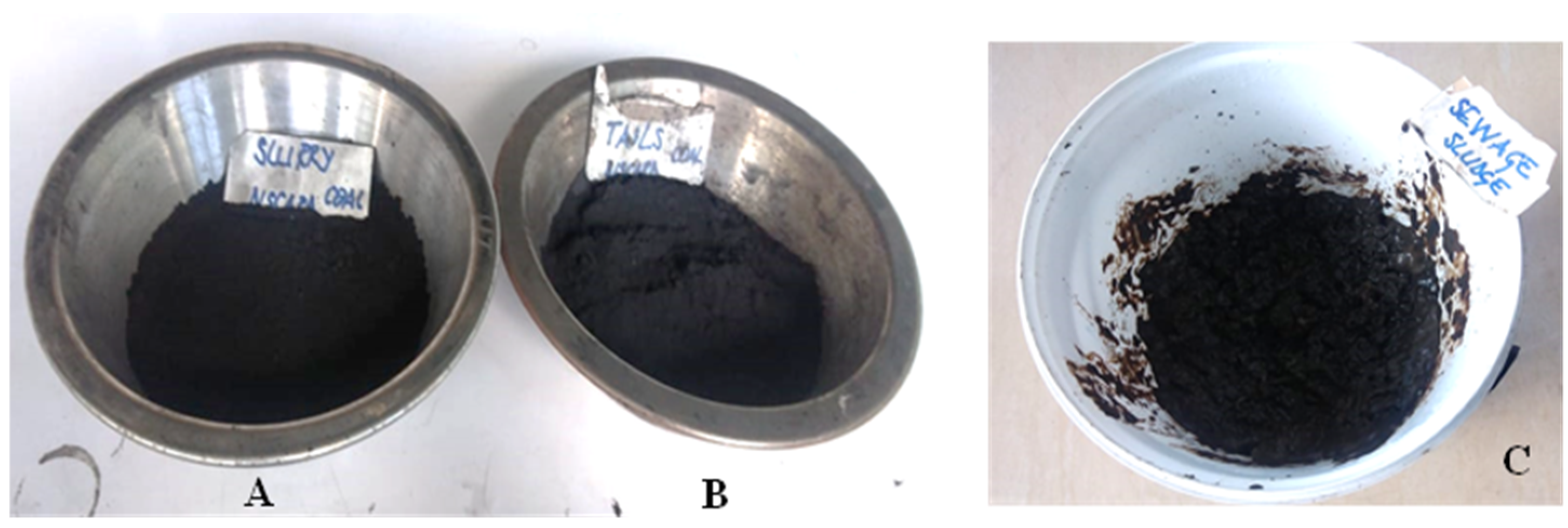
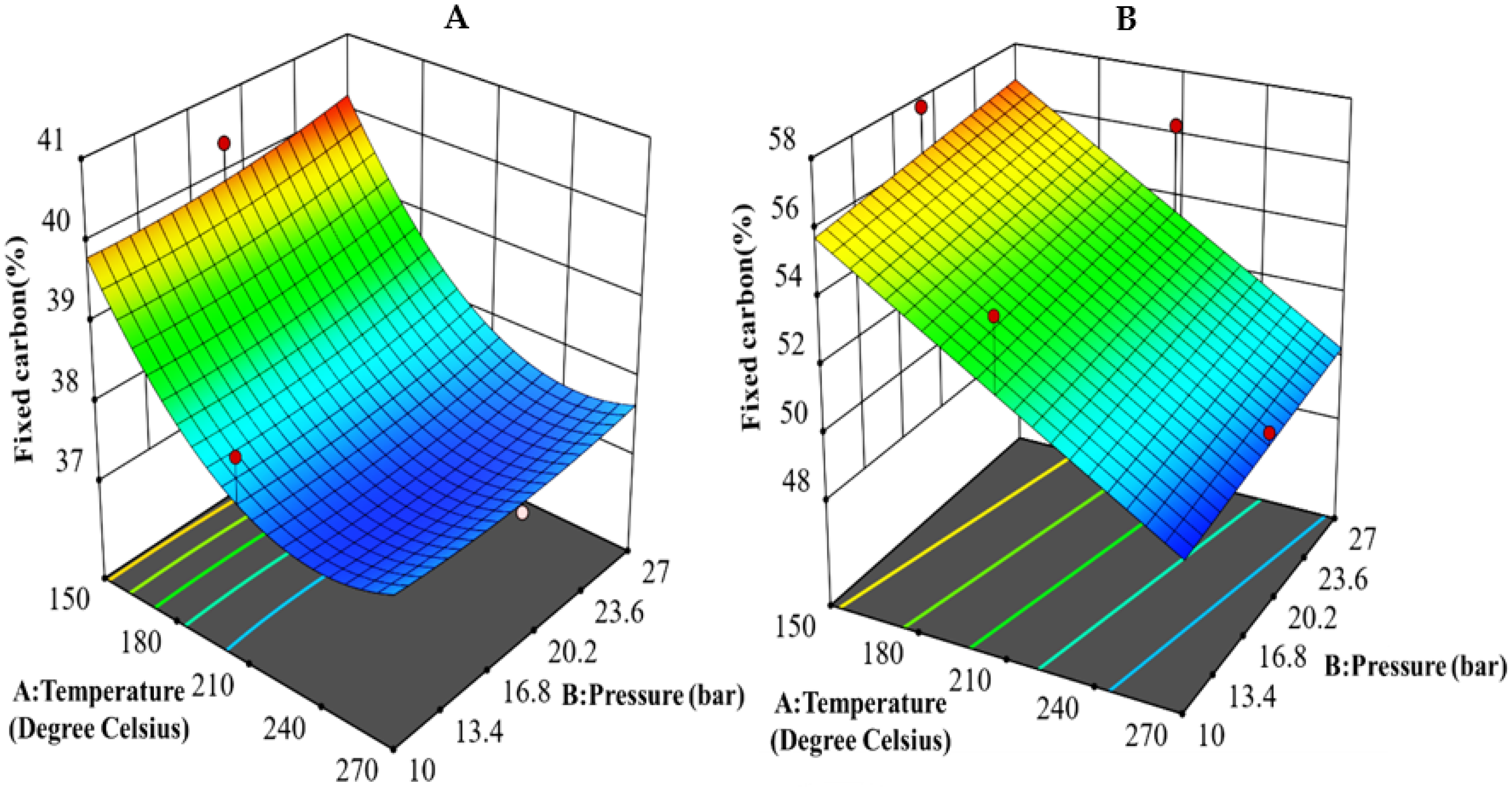
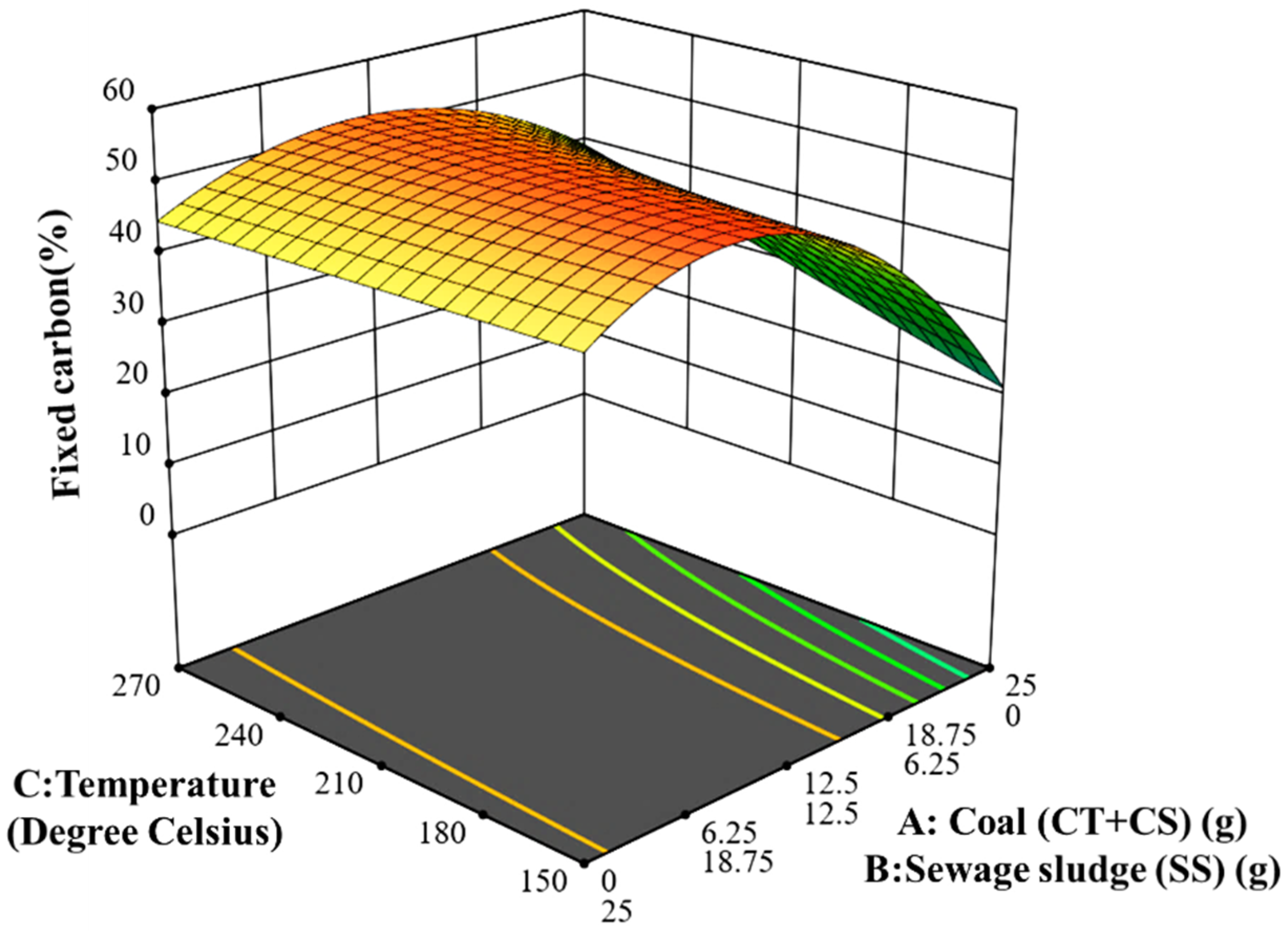




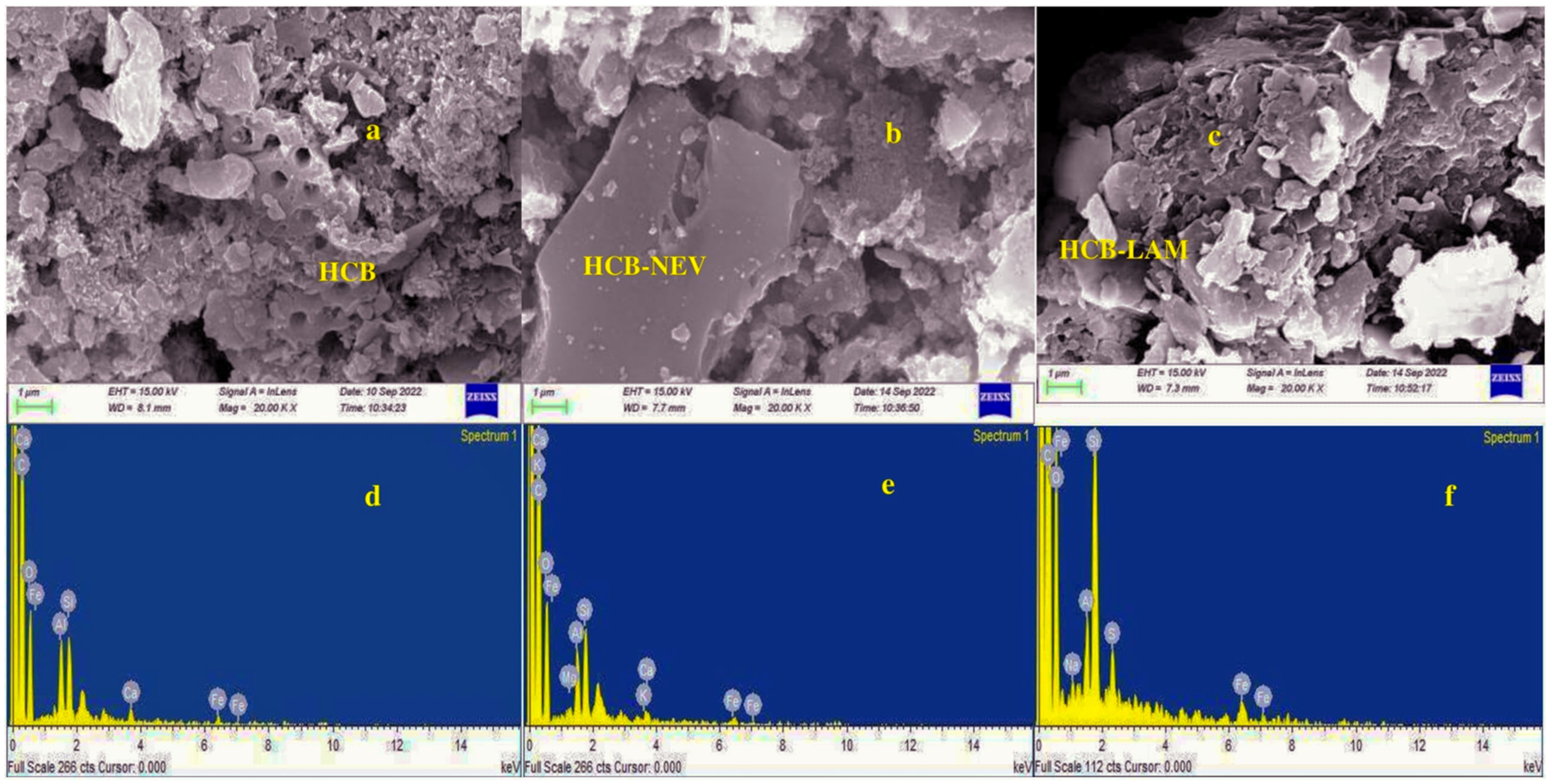


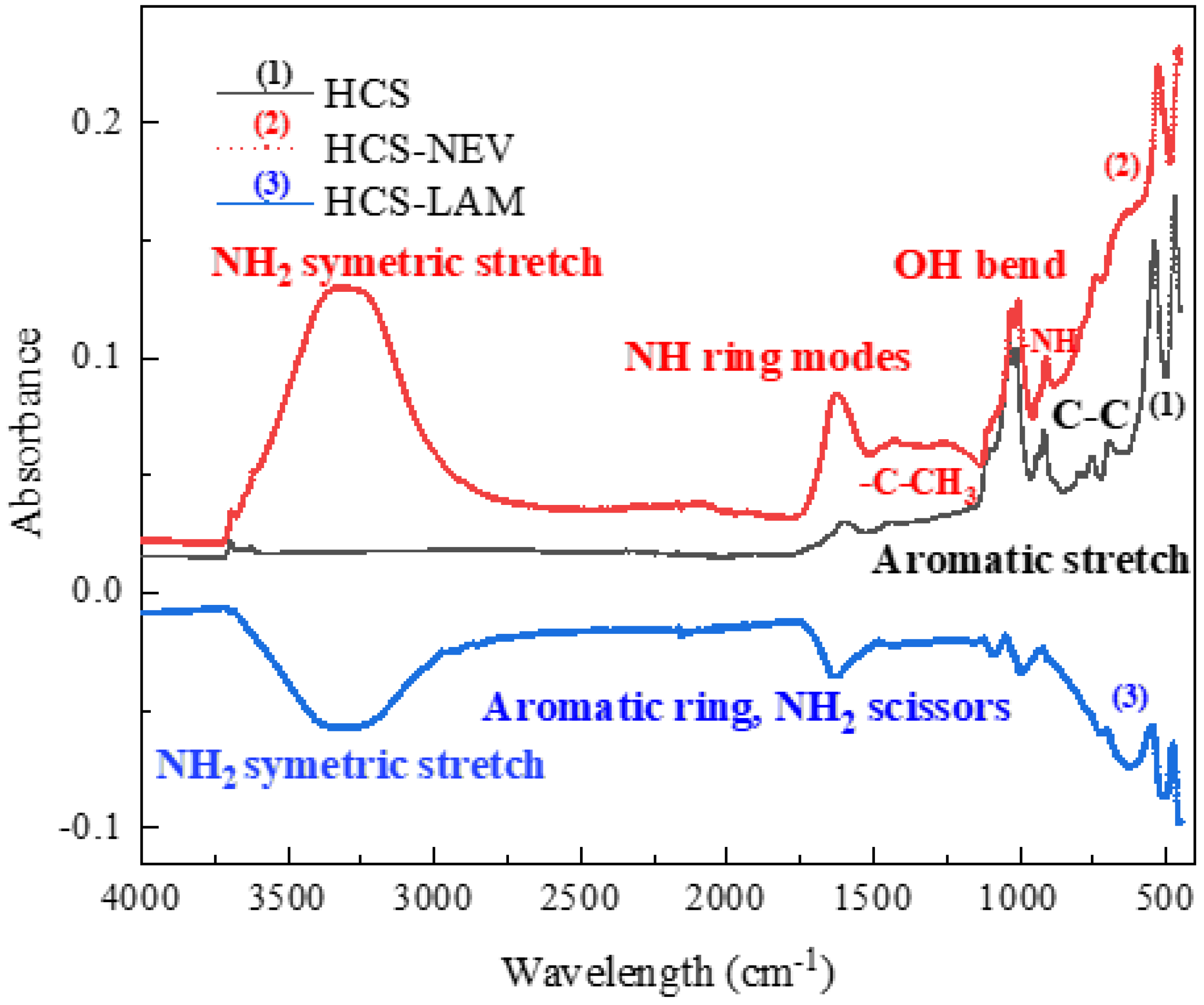
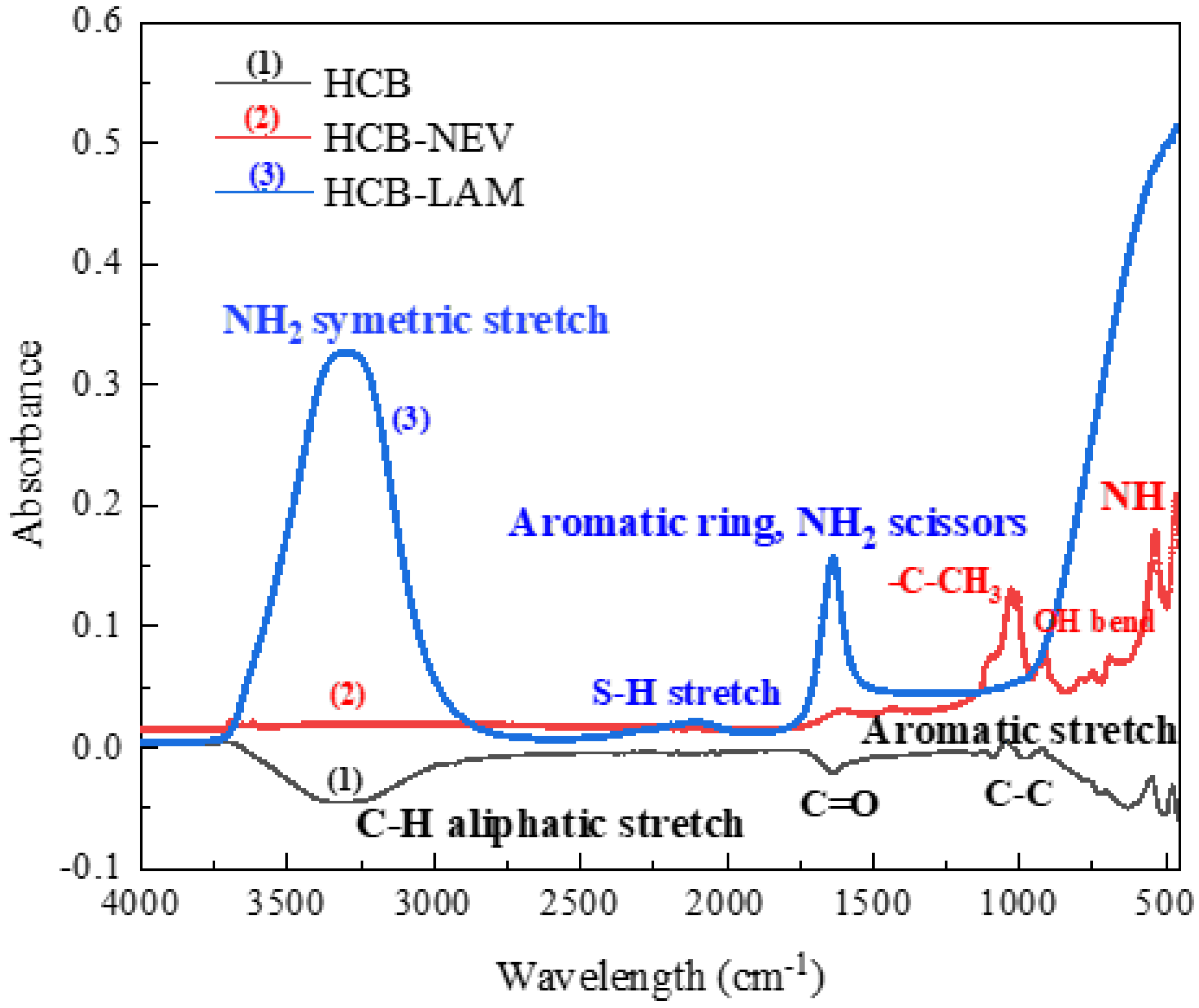
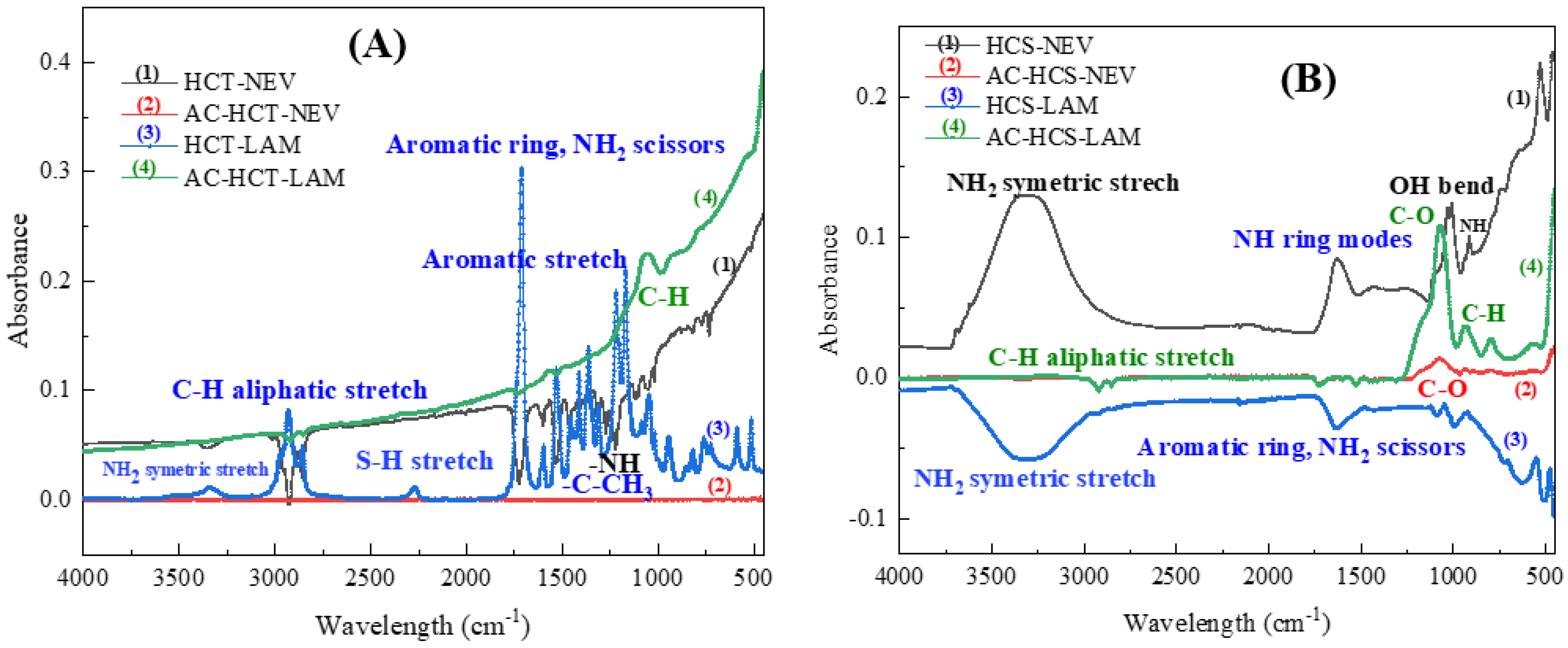



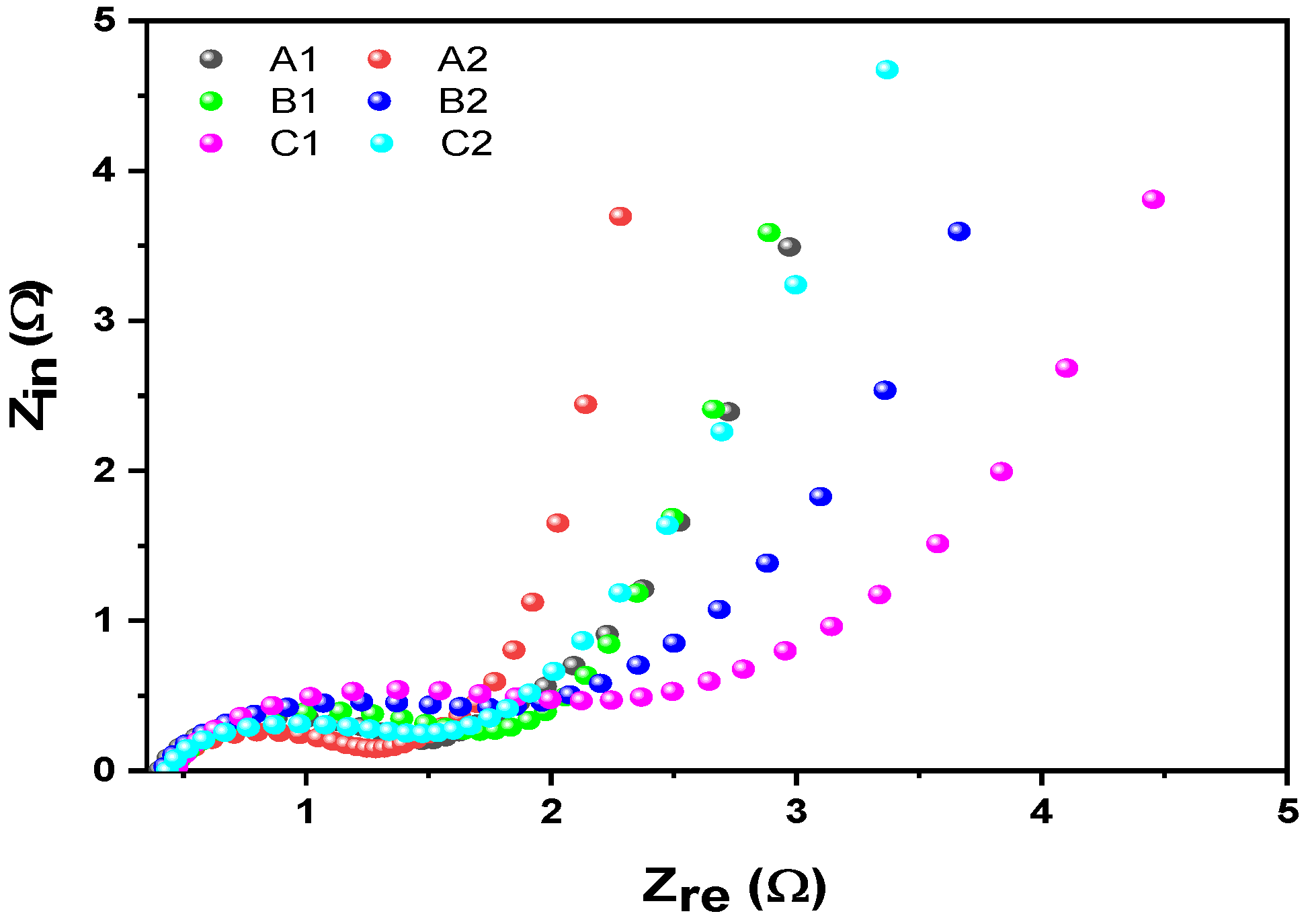
| Name | HCT | HCS | HCB | POAE |
|---|---|---|---|---|
| Parameters | ||||
| Temperature (°C) | 150 | 150 | 208.70 | 0–0.33 |
| Pressure (bar) | 27 | 27 | 22.55 | 0–0.22- |
| Time (Min) | 92.13 | 10 | 331.02 | 0.35–7.4 |
| CT + CS: SS | - | - | 20.02:4.98 | 1.96 |
| Results (%) on a dried basis | ||||
| Ash content | 38.13 | 21.12 | 17.43 | 0.07–1.09 |
| Fixed Carbon | 40.20 | 57.19 | 58.88 | 0.5–1.21 |
| Volatile Matter | 21.67 | 21.69 | 23.69 | 1.08–0.37 |
| Mass yield | 96.18 | 96.05 | 84.67 | 1.35–2.00 |
| Adsorbent (HC) Concentration and Residence Time | HCT | HCS | HCB | ||||||||||||||||||
|---|---|---|---|---|---|---|---|---|---|---|---|---|---|---|---|---|---|---|---|---|---|
| NEV (μg L−1) | STD | pH | LAM (μg L−1) | STD | pH | NEV (μg L−1) | STD | pH | LAM (μg L−1) | STD | pH | NEV (μg L−1) | STD | pH | LAM (μg L−1) | STD | pH | ||||
| Raw solution | 5.53 | 5.58 | 4.58 | 5.34 | 5.53 | 5.58 | 4.58 | 5.34 | 5.53 | 5.58 | 4.58 | 5.34 | |||||||||
| HCs concentration (gL−1) for a residence time of 90 min | |||||||||||||||||||||
| 10 | 3.87 | 1 × 10³ | 5.83 | 3.37 | 1.8 × 10³ | 5.44 | 4.42 | 2.3 × 10³ | 5.67 | 3.87 | 1.7 × 10³ | 5.48 | 3.81 | 2.7 × 10³ | 5.67 | 4.13 | 2.1 × 10³ | 5.46 | |||
| 25 | 2.41 | 1 × 10³ | 6.02 | 2.35 | 1.8 × 10³ | 5.76 | 3.98 | 2.3 × 10³ | 5.94 | 3.61 | 1.7 × 10³ | 5.61 | 1.94 | 2.7 × 10³ | 5.89 | 3.16 | 2.1 × 10³ | 5.59 | |||
| 50 | 0.81 | 1 × 10³ | 6.21 | 1.63 | 1.8 × 10³ | 5.98 | 1.18 | 2.3 × 10³ | 6.17 | 1.94 | 1.7 × 10³ | 6.01 | 0.65 | 2.7 × 10³ | 6.05 | 0.96 | 2.1 × 10³ | 5.77 | |||
| 100 | 0.53 | 1 × 10³ | 6.38 | 0.37 | 1.8 × 10³ | 6.08 | 0.33 | 2.3 × 10³ | 6.42 | 0.47 | 1.7 × 10³ | 6.17 | 0.15 | 2.7 × 10³ | 6.1 | 0.30 | 2.1 × 10³ | 5.84 | |||
| 300 | 0.68 | 8.1 × 10³ | 6.52 | 0.47 | 1.8 × 10³ | 6.14 | 0.44 | 2.3 × 10³ | 6.48 | 0.55 | 1.7 × 10³ | 6.25 | 0.26 | 2.7 × 10³ | 6.22 | 0.40 | 2.1 × 10³ | 5.91 | |||
| Time (minutes) for an HC concentration of 100 g L−1 | |||||||||||||||||||||
| 10 | 1.57 | 8.1 × 10³ | 5.92 | 2.75 | 1.8 × 10³ | 5.59 | 2.60 | 2.3 × 10³ | 6.08 | 2.37 | 1.7 × 10³ | 5.79 | 1.27 | 2.7 × 10³ | 5.67 | 1.66 | 2.1 × 10³ | 5.48 | |||
| 30 | 0.77 | 1 × 10³ | 6.12 | 0.96 | 1.8 × 10³ | 5.87 | 1.35 | 2.3 × 10³ | 6.24 | 0.78 | 1.7 × 10³ | 6.05 | 0.62 | 2.7 × 10³ | 5.88 | 0.75 | 2.1 × 10³ | 5.61 | |||
| 90 | 0.53 | 1 × 10³ | 6.38 | 0.37 | 1.8 × 10³ | 6.08 | 0.33 | 2.3 × 10³ | 6.42 | 0.47 | 1.7 × 10³ | 6.17 | 0.15 | 2.7 × 10³ | 6.11 | 0.30 | 2.1 × 10³ | 5.84 | |||
| 180 | 0.53 | 1 × 10³ | 6.38 | 0.37 | 1.8 × 10³ | 6.08 | 0.33 | 2.3 × 10³ | 6.42 | 0.47 | 1.7 × 10³ | 6.17 | 0.15 | 2.7 × 10³ | 6.11 | 0.30 | 2.1 × 10³ | 5.84 | |||
| 360 | 0.53 | 1 × 10³ | 6.38 | 0.37 | 1.8 × 10³ | 6.08 | 0.33 | 2.3 × 10³ | 6.42 | 0.47 | 1.7 × 10³ | 6.17 | 0.16 | 2.7 × 10³ | 6.11 | 0.30 | 2.1 × 10³ | 5.84 | |||
| Initial Solution from the Mixture (HCB + Nevirapine) | Final Solution after Adsorption (HCB + Nevirapine) | |||||
|---|---|---|---|---|---|---|
| Peak | Retention Time (minutes) | Organic compound Name | Conc (%) | Retention Time (minutes) | Organic compound Name | Conc (%) |
| 1 | 3.287 | Cyclotrisiloxane, hexamethyl- (CAS) | 4.19 | 11.536 | Hexadecanoic acid (CAS) | 26.19 |
| 2 | 3.412 | Cyclotrisiloxane, hexamethyl- (CAS) | 21.28 | 12.515 | 9,12-0ctadecadienoic acid (Z, Z)–(CAS) | 35.02 |
| 3 | 3.557 | Propanoic acid, 2-hydroxy- (CAS) | 4.15 | 12.615 | Octadecanoic acid | 23.82 |
| 4 | 3.655 | DIHYDROXYACETICACID | 0.93 | 12.899 | Hexadecanoic acid, (3-bromoprop-2-ynyl) | 2.7 |
| 5 | 3.72 | Propanal, 3-ethoxy- (CAS) | 1.01 | 13.018 | Hexadecanoic acid, 1-[[[(2-aminoethoxy)hydroxyphosphinyl]oxy]methyl]-2-[(1-oxotetradecyl)oxy] | 1.52 |
| 6 | 4.382 | Propanoic acid, 2-hydroxy- (CAS) | 19.64 | 13.495 | Cis-11-Eicosenoic acid | 0.97 |
| 7 | 4.72 | trisiloxane, 1,1,1,5,5,5-hexamethyl-3 | 0.84 | 13.596 | Eicosanoic acid | 1.89 |
| 8 | 4.765 | Cyclotetrasiloxane, octamethyl- (CAS) | 7.61 | 13.72 | SII.1CONE OIL | 0.48 |
| 9 | 4.948 | 1,3-Dioxane (CAS) | 2.19 | 13.809 | 9,12-0ctadecadienoyl chloride, (Z,Z)- | 0.67 |
| 10 | 6.025 | 0-TRIS-TRIMEfHYLSILYI.rEPIN | 0.97 | 13.94 | Cis-9-Hexadecenal | 0.98 |
| 11 | 6.098 | Cyclopentasiloxane, decamethyl- (CAS) | 4.5 | 14.344 | 11-Cyclopropyl-4-methyl-5, ll-dihydro-6. | 3.76 |
| 12 | 6.87 | 3,3,5-Triethoxy-1,1,1,7,7,7-hexamethyl-5 | 0.33 | 15.003 | Silane, dimethyl(dimethyl(3-methylpentyl) | 0.38 |
| 13 | 7.461 | Cyclohexasiloxane, dodecamethyl | 2.18 | 17.538 | Docosane (CAS) | 0.33 |
| 14 | 8.695 | 3-Ethoxy-1,1,1,7,7,7-hexamethyl-3,5,5 | 0.51 | 18.814 | Tetratetracontane (CAS) | 0.68 |
| 15 | 8.86 | 1-Butylimidazole | 3.39 | 20.38 | Tetratetracontane (CAS) | 0.61 |
| 16 | 8.915 | Emylcamate | 1.7 | |||
| 17 | 8.985 | N-(4-ISOPROPYLBENZVL) -N,1-DIME | 1.51 | |||
| 18 | 9.794 | trimethylsilyl [2,3-di(trimethylsiloxy)pher | 0.84 | |||
| 19 | 10.035 | Chloro(dimethyl)phosphine | 0.29 | |||
| 20 | 10.125 | Erythro-dl-0-ethylthreonine | 0.28 | |||
| 21 | 10.734 | Trimethylsilyl) -{bis[methyl(trimethylsilyh | 0.36 | |||
| 22 | 11.572 | 3-Butoxy-1,1,1,7,7,7-hexamethyl-3,5,5 | 0.59 | |||
| 23 | 11.65 | Histidine, 4-chloro-2-trifluoromethyl | 0.46 | |||
| 24 | 12.155 | 1-Methyl-l-n-tetradecyloxy-1-silacyclope | 0.27 | |||
| 25 | 12.23 | Alpha-(N-methoxy-N-(2;1.;l.-trifluoroethanol | 0.62 | |||
| 26 | 12.338 | 1,1,1,3,5,7,7,7-0ctamethyl-3,5-bis (trime | 0.68 | |||
| 27 | 12.83 | Acetamide, N-(2-cyano 4,5-dimethoxy pht | 0.56 | |||
| 28 | 12.945 | Silane, l,l’-[oxybis(methylene sulfonyl-2,1 | 0.68 | |||
| 29 | 12.985 | Carbonic acid, isohexyl 2;1.;1.-trichloroeth | 0.57 | |||
| 30 | 13.025 | EICOSAMETHYLCYCLODECASILQ) | 0.77 | |||
| 31 | 13.185 | Succinylacetone diethoxime, trimethylsily | 0.29 | |||
| 32 | 13.265 | Pentanoic acid, butyl ester (CAS) | 0.29 | |||
| 33 | 13.373 | Morpholine, 4-(2,4-dinitrophenylbenzoyl) | 0.63 | |||
| 34 | 13.585 | d-Altronic acid | 0.32 | |||
| 35 | 13.67 | Butyl heptanoate | 0.56 | |||
| 36 | 13.719 | Heptasiloxane, hexadecamethyl | 1.07 | |||
| 37 | 14.03 | N-Acetyl- alpha-aminooxy-propionic acic | 0.45 | |||
| 38 | 14.392 | Benzene, (1-methoxyethenyl) | 0.65 | |||
| 39 | 14.501 | Heptasiloxane, hexadecamethyl-(CAS) | 0.62 | |||
| 40 | 15.314 | 5-Chloro-IH-l;1.,4-triazole-3-carboxamid | 0.42 | |||
| 41 | 15.435 | Benzeneacetic acid, alpha.,3,4-tris[(trike | 1.55 | |||
| 42 | 15.855 | (1-methylethyl)-thiirane | 0.36 | |||
| 43 | 15.92 | Ethyl 2-nitropropionatc | 0.62 | |||
| 44 | 17.548 | Nonane, 5-(1-methylpropyl} - | 0.93 | |||
| 45 | 18.824 | Hepladecane, 2,6,10,15-tctramcthyl- (CA | 2.94 | |||
| 46 | 20.26 | D-Glucose, 6-acctamido-6-deoxy-, diethy | 0.61 | |||
| 47 | 20.398 | Sulfurous acid, octadccyl 2-propyl ester | 2.2 | |||
| 48 | 20.47 | 1-Phenazinecarboxylic acid, 6-[l-[(l-oxo)]] | 0.28 | |||
| 49 | 22.255 | 1,2,4-Triazolo [3,4-a] phthalazine-7-hydrn | 0.26 | |||
| 50 | 22.318 | Octadccane, 5-methyl | 1.05 | |||
| 100 | ||||||
| Initial Solution from the Mixture (HCB + Lamivudine) | Final Solution after Adsorption (HCB + Lamivudine) | |||||
|---|---|---|---|---|---|---|
| Peak | Retention Time (minutes) | Organic compound Name | Conc (%) | Retention Time (minutes) | Organic compound Name | Conc (%) |
| 1 | 3.34 | Cyclotrisiloxane, hexamethyl- (CAS) | 1.54 | 3.35 | Cyclotrisilox ane, hexamethyl- (CAS) | 0.29 |
| 2 | 3.375 | 3,4-Dimethylbenzoicacid, TBDMS deri• | 0.7 | 3.518 | Cyclotrisiloxane, hexamethyl- (CAS) | 0.56 |
| 3 | 3.441 | Cyclotetrasiloxane, octamethyl- (CAS) | 8.83 | 4.81 | Cyclotetrasiloxane, octamethyl- (CAS) | 0.24 |
| 4 | 4.56 | Cyclotetrasiloxane, octamethyl- (CAS) | 0.54 | 5.467 | 1,2,3-Propanetriol (CAS) | 98.52 |
| 5 | 4.63 | BENZENE, (1,1-DIMETHYLETI YL) | 2.55 | 6.28 | Disiloxane, l, l,3,3-tetramethyl-l,3-bis [3] | 0.39 |
| 6 | 4.704 | Tridecane (CAS) | 2.11 | |||
| 7 | 4.792 | Cyclotetrasiloxane, octamethyl- (CAS) | 7.76 | |||
| 8 | 5 | Butyric acid, 2-phenyl-, hept-2-yl ester | 1.06 | |||
| 9 | 5.364 | Heptane, 5-ethyl-2-methyl-(CAS) | 1.3 | |||
| 10 | 5.44 | Ethyl neopentyl carbonate | 0.47 | |||
| 11 | 5.612 | l-MEfHYL-2-PHENYLCYCLOPROPJ | 3.03 | |||
| 12 | 5.718 | Undecane (CAS) | 1.81 | |||
| 13 | 6.099 | Cyclopentasiloxane, decamethyl- (CAS) | 0.66 | |||
| 14 | 6.153 | Cyclopentasiloxane, decamethyl- (CAS) | 0.84 | |||
| 15 | 6.757 | Dodecane (CAS) | 2.9 | |||
| 16 | 6.875 | Carbonic acid, 2-ethoxyethyl neopentyl | 0.63 | |||
| 17 | 7.165 | Oxalic acid, hexyl neopentyl ester | 0.76 | |||
| 18 | 7.19 | 2-Propyl-5-oxohexanoic acid | 0.86 | |||
| 19 | 7.234 | 1-Heptadecanamine (CAS) | 2.81 | |||
| 20 | 7.465 | CYCLOHEXASILOXANE, OODECM | 1.1 | |||
| 21 | 7.531 | Tridecane (CAS) | 4.51 | |||
| 22 | 8.011 | Tetradecane (CAS) | 1.59 | |||
| 23 | 8.269 | Hexadecane (CAS) | 2.32 | |||
| 24 | 8.33 | 5-Allyl-6-methyl-2-phenyl-5,6-dihydro-4 | 0.54 | |||
| 25 | 8.695 | (E)-2-[(tert-butyl) dimethylsily! J-2- [I’-me | 1.93 | |||
| 26 | 8.746 | Octadecane, l,1’- [1,3-propanediylbis (ox) | 0.95 | |||
| 27 | 8.941 | Pentadecane (CAS) | 3.08 | |||
| 28 | 9.144 | 1-Bromo-3,7-dimethyloctane | 0.57 | |||
| 29 | 9.235 | Decanoic acid, nonyl ester | 0.59 | |||
| 30 | 9.264 | PENTASIWXANE, 1, l,3,3,5,5,7,7,9,9- | 1.6 | |||
| 31 | 9.42 | Dodecane, 1,2-dibromo- (CAS) | 0.51 | |||
| 32 | 9.583 | Pentadecane (CAS) | 2.12 | |||
| 33 | 10.198 | Heptadecane (CAS) | 2.31 | |||
| 34 | 10.435 | Tridecane, 6-propyl- | 1.92 | |||
| 35 | 10.575 | 3beta,17beta-Diacetoxy-17-isopregn-5-e | 0.45 | |||
| 36 | 10.772 | Octadecane (CAS) | 1.29 | |||
| 37 | 10.875 | 9-Oxa-10-thiatricyclo [3.3.I. I (2,7) Jdecar | 0.63 | |||
| 38 | 11.019 | Undecane, 6-ethyl- | 0.73 | |||
| 39 | 11.105 | (−)-lsopulegol | 0.51 | |||
| 40 | 11.161 | DIMETHOXYGLYCEROLDOCOSYL | 0.55 | |||
| 41 | 11.324 | Tricosane (CAS) | 1.06 | |||
| 42 | 11.843 | NONADECANE | 1.57 | |||
| 43 | 12.346 | Tetradecane (CAS) | 1.07 | |||
| 44 | 12.825 | Heptacosane (CAS) | 0.69 | |||
| 45 | 12.91 | Pentasiloxane, 1,1,3,3,5,5,7,7,9,9-decam | 0.5 | |||
| 46 | 13.01 | 1-Hcptcnc, 2,6,6-trimethyl- | 0.7 | |||
| 47 | 14.433 | 11-Cyclopropyl-4-methyl-5, l l--dihydro-t | 21.89 | |||
| 48 | 15.435 | Benzene, 1-(1, l-dimethylcthyl) -4-(2-ethyl | 0.44 | |||
| 49 | 18.775 | Pentasiloxanc, dodecamethyl- (CAS) | 0.55 | |||
| 50 | 19.056 | 3-Thiazolidinccarboxamidine, 2-imino- | 0.57 | |||
| 100 | ||||||
| Analyses | CT | HCT | HCT–NEV | HCT–LAM | CS | HCS | HCS–NEV | HCS–LAM | SS | CB | HCB | HCB–NEV | HCB–LAM |
|---|---|---|---|---|---|---|---|---|---|---|---|---|---|
| Proximate Analysis (wt. %, adb) | |||||||||||||
| Inherent Moisture | 4.17 | 1.07 | 1.81 | 1.04 | 3.94 | 1.73 | 1.58 | 1.26 | 8.12 | 2.71 | 1.72 | 1.76 | 1.45 |
| Ash content | 38.64 | 37.96 | 33.12 | 33.96 | 23.22 | 22.78 | 19.78 | 16.78 | 36.07 | 37.75 | 19.56 | 13.56 | 19.56 |
| Volatile Matter | 21.44 | 21.04 | 22.86 | 24.49 | 21.28 | 18.38 | 19.2 | 23.72 | 47.07 | 21.92 | 20.31 | 22.16 | 25.26 |
| Fixed Carbon | 35.75 | 39.94 | 42.21 | 40.51 | 50.98 | 57.11 | 59.44 | 58.24 | 8.75 | 37.62 | 58.41 | 62.52 | 60.73 |
| Ultimate Analysis (wt. %, adb) | |||||||||||||
| Total Carbon | 42.82 | 49.80 | 55.23 | 53.98 | 61.85 | 66.90 | 70.90 | 69.45 | 29.7 | 45.64 | 67.04 | 73.85 | 68.44 |
| Hydrogen | 3.01 | 2.87 | 2.42 | 2.39 | 3.56 | 2.98 | 2.28 | 2.41 | 4.88 | 3.05 | 2.78 | 1.75 | 1.57 |
| Nitrogen | 1.14 | 1.72 | 2.74 | 2.66 | 1.39 | 1.99 | 2.63 | 2.84 | 4.15 | 1.82 | 2.43 | 3.05 | 2.95 |
| Oxygen | 8.79 | 5.83 | 3.9 | 4.21 | 4.78 | 2.75 | 1.91 | 3.99 | 15.22 | 8.2 | 6.08 | 5.29 | 4.15 |
| Total Sulfur (wt. %, adb) | 1.43 | 0.75 | 0.78 | 1.76 | 1.26 | 0.87 | 0.92 | 1.27 | 1.86 | 0.83 | 0.39 | 0.74 | 1.88 |
| BET analysis | |||||||||||||
| SBET (m2/g) | 6.066 | 11.82 | 0 | 0 | 6.37 | 14.35 | 0 | 0 | - | 6.17 | 20.35 | 0 | 0 |
| Total pore volume (cm3/g) | 0.034 | 0.071 | 0 | 0 | 0.048 | 0.094 | 0 | 0 | - | 0.09 | 0.38 | 0 | 0 |
| Adsorbent | Adsorbate (Pharmaceutical) | Adsorbent Concentration (g L−1) | Contact Time (min) | Uptake mg g−1 | Reference |
|---|---|---|---|---|---|
| Commercial carbon | Nalidixic acid | 0.08 | 325 | 1595 | Patiño (2016) [54] |
| Carbon nanotube | Nalidixic acid | 0.08 | 150 | 583 | |
| Graphite | Nalidixic acid | 0.08 | 10 | 62 | |
| Akaganeite-carbon | Doxycycline | 0.027 | 108 | 13.4 | Zhang (2016) [55] |
| Coffee residue/Fe3O4 | Tetracycline | 0.1 | 85.9 | 181 | Oladipo (2016) [56] |
| Bone char | Naproxen | 0.01 | 78 | 0.11 | Reynel (2015) [57] |
| Walnut shell carbon | Cephalexin | 0.1 | 117.1 | 211 | Nazari (2016) [58] |
| Peach stones carbon | Ibuprofen | 0.01 | 426 | 55 | Álvarez. (2016) [59] |
| Tetracycline | 0.01 | 1446 | 132.6 | ||
| Activated biochar | Ranitidine | 0.2 | 63 | 12 | Mondal (2016) [60] |
| Akaganeite-carbon | Doxycycline | 0.027 | - | 15 | Zhang (2016) [55] |
| Date stones carbon | Levofloxacin | 0.15 | - | 2.1 | Darweesh (2017) [61] |
| Pomegranate carbon | Amoxicillin | 0.05 | - | 5107 | Yaghmaeian (2014) [62] |
| AC from oak acorn | Paracetamol | 45.45 | Nourmoradi (2018) [63] | ||
| AC from Babassu coconut | 71.39 | Ferreira (2015) [64] | |||
| AC from Dende coconut | 70.62 | ||||
| NH4Cl-induced AC | 233 | Mashayekh-Salehi and Moussavi (2016) [65] | |||
| Acid-treated beverage sludge-activated carbon | 145.4 | Streit (2021) [66] | |||
| AC from vegetable | Ibuprofen | 115.1 | Frohlich (2018) [67] | ||
| AC from agricultural by-products | 12.6 | Baccar (2012) [68] | |||
| AC from oak acorn | 96.15 | Nourmoradi (2018) [63] | |||
| AC from vegetable | Ketoprofen | 79.1 | Frohlich (2018) [67] | ||
| Acid-treated beverage sludge-activated carbon | 57.66 | Streit (2021) [66] | |||
| Nanofibers fabricated from Mondia whitei | ARVs | 0.04 | 0–120 | 75–320 | Kebede (2020) [12] |
| Graphene-based material | Nevirapine | 0.2 | 1500 | 48.31 | Adeola (2021) [69] |
| Graphene-based material | efavirenz | 0.2 | 500 | 4.41 | |
| AC from Spent brewery grains | sulfamethoxazole | 0.025 | 60 | 217 | Sousa (2022) [27] |
| trimethoprim | 0.025 | 60 | 229.35 | ||
| ciprofloxacin | 0.025 | 60 | 205.7 | ||
| AC from primary paper mill sludge | sulfamethoxazole | 0.8 | - | 185.14 | Silva (2019) [26] |
| Functionalized biochar | sulfamethoxazole | 0.01 | 80.79 | Ahmed (2017) [31] | |
| Graphene oxide | lamivudine | 0.1 | 120 | 10.08 | Lan (2022) [32] |
| Molecularly imprinted polymers (MIPs) | Abacavir | 60 | 167 | Terzopoulou (2016) [70] | |
| Graphene wool | Efavirenz | 4.41 | |||
| Nevirapine | 48.31 | ||||
| Alginate, polyvinylpyrrolidone and activated carbon | 44.4 | Ndilimeke. (2021) [13] | |||
| Zidovudine | 42.2 | ||||
| Nanofibers (Mondia White roots) | Nevirapine | 200.5 | Kebede (2020) [12] | ||
| Didanosine | 75.9 | ||||
| Ritonavir | 86.9 | ||||
| Efavirenz | 152.1 | ||||
| Stavudine | 160 | ||||
| Biochar made from- olive | Abacavir | Optimum value not reported, exhibited poor removal efficiencies | Späth (2021) [71] | ||
| Residues, tomato residues | Atazanavir | ||||
| Rice husks, and the African | Darunavir | ||||
| Palm tree Raphia farinifera | Lamivudine | ||||
| Nevirapine | |||||
| Raltegravir | |||||
| HCT | Nevirapine | 100 | 90 | 50 | This study |
| Lamivudine | 42 | ||||
| HCS | Nevirapine | 52 | |||
| Lamivudine | 41.1 | ||||
| HCB | Nevirapine | 53.8 | |||
| Lamivudine | 42.8 |
| Material | Surface Area (m2/g) | Total Pore Volume (cm3/g) | Micropore Volume (cm3/g) | Average Pore Diameter (nm) |
|---|---|---|---|---|
| AC–HCT–NEV | 1047.5 | 1.14 | 0.986 | 2.23 |
| AC–HCT–LAM | 748.2 | 0.47 | 0.353 | 2.55 |
| AC–HCS–NEV | 618.4 | 0.373 | 0.289 | 2.41 |
| AC–HCS–LAM | 582.8 | 0.442 | 0.255 | 3.04 |
| AC–HCB–NEV | 436.5 | 0.42 | 0.16 | 3.85 |
| AC–HCB–LAM | 603.6 | 0.473 | 0.262 | 3.13 |
Publisher’s Note: MDPI stays neutral with regard to jurisdictional claims in published maps and institutional affiliations. |
© 2022 by the authors. Licensee MDPI, Basel, Switzerland. This article is an open access article distributed under the terms and conditions of the Creative Commons Attribution (CC BY) license (https://creativecommons.org/licenses/by/4.0/).
Share and Cite
Kahilu, G.M.; Bada, S.; Mulopo, J. Coal Discards and Sewage Sludge Derived-Hydrochar for HIV Antiretroviral Pollutant Removal from Wastewater and Spent Adsorption Residue Evaluation for Sustainable Carbon Management. Sustainability 2022, 14, 15113. https://doi.org/10.3390/su142215113
Kahilu GM, Bada S, Mulopo J. Coal Discards and Sewage Sludge Derived-Hydrochar for HIV Antiretroviral Pollutant Removal from Wastewater and Spent Adsorption Residue Evaluation for Sustainable Carbon Management. Sustainability. 2022; 14(22):15113. https://doi.org/10.3390/su142215113
Chicago/Turabian StyleKahilu, Gentil Mwengula, Samson Bada, and Jean Mulopo. 2022. "Coal Discards and Sewage Sludge Derived-Hydrochar for HIV Antiretroviral Pollutant Removal from Wastewater and Spent Adsorption Residue Evaluation for Sustainable Carbon Management" Sustainability 14, no. 22: 15113. https://doi.org/10.3390/su142215113
APA StyleKahilu, G. M., Bada, S., & Mulopo, J. (2022). Coal Discards and Sewage Sludge Derived-Hydrochar for HIV Antiretroviral Pollutant Removal from Wastewater and Spent Adsorption Residue Evaluation for Sustainable Carbon Management. Sustainability, 14(22), 15113. https://doi.org/10.3390/su142215113







